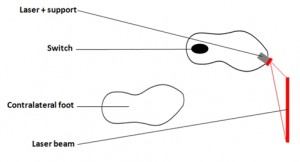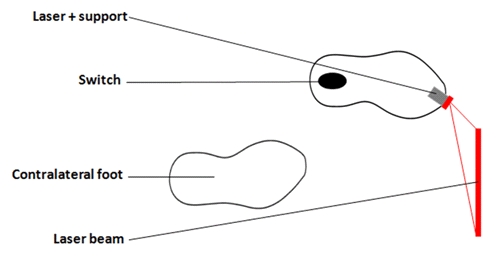This post is also available in Dutch.
Imagine trying to walk when your feet are suddenly glued to the floor. This phenomenon known as freezing of gait is a very disabling symptom of Parkinson’s disease. Now, you can find out how a simple pair of shoes equipped with lasers can drastically reduce freezing, over and above other therapeutic treatments.
 Schematic representation of the so-called Cue-shoe working mechanism, by Murielle Ferraye
Schematic representation of the so-called Cue-shoe working mechanism, by Murielle Ferraye
Parkinson’s disease is a neurodegenerative disorder which means that it is caused by the progressive loss of nerve cells, within the brain, that release dopamine. Dopamine is a chemical in the brain that plays an important role during movement and reward (for behavior). Parkinson’s disease is characterized by motor problems including tremor, muscle rigidity, slowness of movement, and gait (movement) difficulty. In particular, freezing of gait (a sudden stop in walking pattern) affects up to 70 % of Parkinson patients after 10 years of disease progression. Freezing increases the risk of falls and related injuries and is commonly induced by several factors including turning, gait initiating, walking through narrow doorways and double tasking. Unfortunately, freezing inconsistently responds to current pharmacological (dopaminergic therapy) and surgical treatments.
External cues for freezing
Freezing is an interesting phenomenon because it is highly influenced by our attention, motivation, and emotions. This characteristic of freezing can be used in rehabilitation strategies by providing patients with tricks to help them overcome freezing episodes. For example, cues in the environment (external cues) can help patients to generate stepping movements. These cues can occur in time or in space, and give information on how an action should be carried out. Lines placed at regular intervals on the floor, stair tiles, or the sound of a metronome, are some examples of external cues shown to have successfully decreased freezing of gait.
In Parkinson’s disease, the degeneration of the dopaminergic neurons induces a loss of automaticity of movements. Patients initially compensate for this by paying more attention and using more cognitive effort. However, the development of cognitive dysfunction at later stages of the disease makes it more and more difficult for the patients to rely solely on attention and focus to compensate for their gait problems. Freezing is then likely to appear. According to this, external cues are effective because they reduce the attentional demands of gait (removing the need to internally plan and prepare the stepping movements). This makes it not only an effective rehabilitation strategy for patients in initial but potentially also for patients at later stages of the disease.
The Cue-shoe
We developed the Cue-shoe, a new laser-based cueing device. The Cue-shoe consists of a normal pair of shoes equipped with a line-generating laser mounted on the nose of each shoe. The particularity of this shoe stems from the strategic location of a pressure-sensitive switch – one under the sole of each shoe – that controls the laser. The loading of body weight onto the switch (upon heel contact) turns on the laser. The laser is oriented to project its beam orthogonally, in front of the patient’s opposite foot that is about to be lifted. The laser line acts as the visual cue (see image). The visual cues are delivered intermittently and, importantly, are tuned exactly to the step frequency of the patient. The Cue-shoe is an ambulatory device, so that the visual cues can be always present. It is an elegant and user-friendly form of visual cueing with great potential to alleviate freezing, even in those with advanced stages of the disease.
This blog was written by Murielle Ferraye. Murielle (1983) joined the Donders Institute as a post-doctoral researcher, supported by a Rubicon grant to study the cerebral bases of freezing of gait and altered balance control in Parkinson’s disease. Since her PhD thesis in Grenoble (France) she is interested in increasing knowledge on this debilitating symptom, with a strong drive to find clinical solutions for the patients. Direct clinical implication is indeed at the center of her research studies. This led her to the idea of the Cue-shoe as a new medical device. Recently, she obtained a Hersenstichting grant to test the efficacy of this potentially promising cueing device on freezing of gait.
Edited by Mahur.
